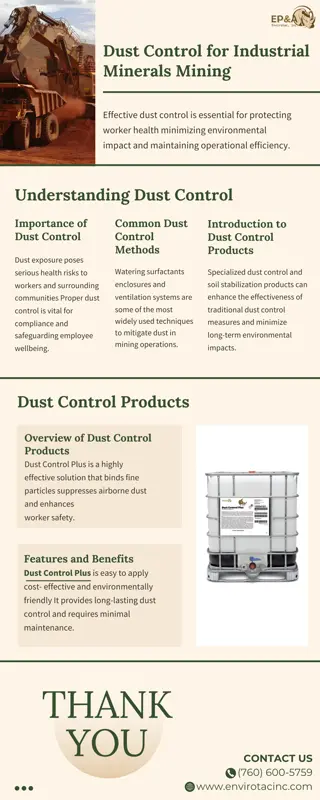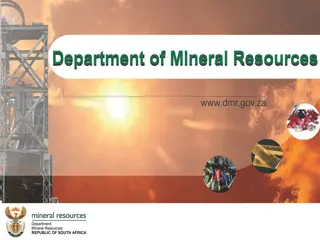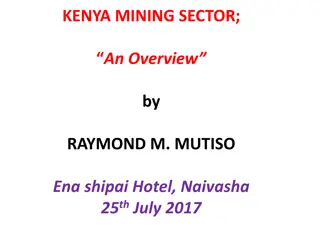Overview of Unit Operations in Mining
Unit operations in mining involve essential steps to extract minerals from deposits through processes like drilling, blasting, loading, and hauling. These operations are crucial for the successful extraction of minerals in both surface and underground mining. Efforts are being made to increase the continuity and efficiency of mining processes. Various techniques such as drilling, blasting, and materials handling play a vital role in the production cycle within the mining industry.
Download Presentation

Please find below an Image/Link to download the presentation.
The content on the website is provided AS IS for your information and personal use only. It may not be sold, licensed, or shared on other websites without obtaining consent from the author.If you encounter any issues during the download, it is possible that the publisher has removed the file from their server.
You are allowed to download the files provided on this website for personal or commercial use, subject to the condition that they are used lawfully. All files are the property of their respective owners.
The content on the website is provided AS IS for your information and personal use only. It may not be sold, licensed, or shared on other websites without obtaining consent from the author.
E N D
Presentation Transcript
UNIT OPERATIONS IN MINING Sk Sk johnsaheb johnsaheb
1. INTRODUCTION: The unit operations are referred as the basic operations that need to be carried out to dig out or excavate ground and dispose off the spoil so generated to a particular destination during mining operations. These operations are mandatory during any phase of mine-life i.e. development and exploitation, in order to mine out a deposit by the application of any of the mining methods in practice. The unit operations of mining are the basic steps used to produce mineral from the deposit, and the auxiliary operations that are used to support them. The steps contributing directly to mineral extraction are production operations, which constitute the production cycle of operations. The ancillary steps that support the production cycle are termed auxiliary operations. The production cycle employs unit operations that are normally grouped into rock breakage and materials handling. Breakage generally consists of drilling and blasting, and materials handling encompasses loading or excavation and haulage (horizontal transport) and sometimes hoisting (vertical or inclined transport). Thus, the basic production cycle consists of these unit operations:
Production cycle = drill + blast + load + haul Term cycle implies that the mining operations are cyclic or repetitive in nature but efforts are being made to make the process continuouswhere the mineral/rock/ground after breaking moves without interruption. Truly speaking this should be the ultimate aim but we are far away from such a system. Number of techniques can fragment the rock but the prominent amongst them is drilling and blasting. Although production operations tend to be separate and cyclic in nature, the trend in modern mining and tunneling is to eliminate or combine functions and to increase continuity of extraction. For example, in coal and other soft rock mines, continuous miners break and load the mineral to eliminate drilling and blasting; boring machines perform the same tasks in medium-hard rock. The cycle of operations in surface and underground mining differs primarily by the scale of the equipment. Specialized machines have evolved to meet the unique needs of the two regimes.
In modern surface mining, blast holes of 75 to 380 mm in diameter are produced by rotary or percussion drills for the placement of explosives when consolidated rock must be removed. The explosive charge is then inserted and detonated to reduce the overburden or ore to a size range suitable for excavation. The broken material is loaded by shovel, dragline, or wheel loader into haulage units - generally trucks - for transport. Rail road cars are also used for haulage, and belt conveyors are often used after the material is crushed. Soil and coal are often moved in the same manner, though blasting is sometimes unnecessary. In the quarrying of dimension stone, the blocks are often freed without blasting, using wire saws or other mechanical devices. In underground mining, the production cycle is similar, although the equipment used may be scaled down in size. Smaller drill holes are used, trucks are sometimes replaced by shuttle cars, and belt conveyors are more prevalent. Coal, salt, potash, and trona are often mined without the use of explosives or mined after undercutting the face to reduce the consumption of explosives. In addition to the operations of the production cycle, certain auxiliary operations must be performed in many cases. Underground, these usually include roof support, ventilation and air conditioning, power supply, pumping, maintenance, lighting, communications, and delivery of compressed air, water, and supplies to the working sections. In surface mining, the primary auxiliary operations include those providing slope stability, pumping, power supply, maintenance, waste disposal, and supply of material to the production centers.
2. PRIMARY ROCK BREAKING: Detaching the large rock mass from its parent deposit is known as rock breakage. Since pre- historic time man devised several ways to achieve this task and he made the greatest technological advance in mining history when eventually he discovered explosive and used it for rock breaking purposes. Application of explosive in the rock is carried out by means of drilling holes, which are known as shot holes, blast holes or big blast holes depending upon their length and diameter. Holes of small diameter (32-45 mm) and short length (up to 3 m) are termed as shot holes, and they are drilled during tunneling and drivage work in mines. The blast holes are longer (exceeding 3 m to 40 m or so) and larger in diameter (exceeding 45 mm to 75 mm or so), and that are drilled as cut-holes in tunnels and drives, and in the stopes. Besides their use in surface mines, recently use of very large diameter (exceeding 75 mm) long holes, known as big blast holes, have begun for the raising and stoping operations in underground mines too. Thus, to dislodge the rock from its rock-mass, if use of suitable drills, explosives and blasting techniques, is made.
3. DRILLING: The drilling with few exceptions such as: exploration, to provide drainage, in fixing rock bolts, in stabilizing slopes and to test foundations, is employed in mining and tunneling for placement of explosives. Figure 1, illustrates the application of this operation.
Drilling is the process of making a hole into a hard surface where the length of the hole is very large compared to the diameter. In the context of mining engineering drilling refers to making holes into a rock mass. Surface mining requires drilling for different purposes that include: 1. Production drilling i.e. for making holes for placement of explosives for blasting. The objective of drilling and blasting is to prepare well-fragmented loose rock amenable to excavation with better productivity from the excavation machinery. The holes drilled for this purpose are defined as blast hole. 2. Exploration drilling for sample collections to estimate the quality and quantity of a mineral reserve. The samples are collected as core and the drilling for such purposes are referred as Core drilling. As diamond bits are used for such drilling, core drilling is often called diamond drilling. 3. Technical drilling during development of a mine for drainage, slope stability and foundation testing purposes.
Opencast mining involves removal of waste rock and subsequent winning of the mineral. In case of deposits underlying hard and compact waste rock called overburden loosening of the rock mass is essential prior to excavation. Thus drilling and blasting is the important ground preparation job. Unless the rock mass is highly weathered and very much unconsolidated drilling of holes for placement of explosives and detonating them for blasting is required for any mining operation. Modern machines like continuous surface miner can however eliminate the need of drilling and blasting in certain surface mining operations. Successful drilling under specific site conditions requires blending many technologies and services into a coherent efficient team, particularly if it is for deep exploration drilling. Blast hole drilling is comparatively simpler. However, to minimize costs and optimize the performance and post drilling operations technical managers and decision managers must understand the language and technology of drilling operations.
4. OPERATING COMPONENTS OF THE DRILLING SYSTEM There are four main functional components of a drilling system, working in the following manner to attack the rock as illustrated in figure 2(d). 1. The drill: it acts as prime mover converting the original form of energy that could be fluid, pneumatic or electric into the mechanical energy to actuate the system. 2. The rod (or drill steel, stem or pipe): it transmits the energy from prime mover to the bit or applicator. 3. The bit: it is the applicator of energy attacking the rock mechanically to achieve penetration. 4. The circulation fluid: it cleans the hole, cools the bit, and at times stabilizes the hole. It supports the penetration through removal of cuttings. air, water or sometimes mud can be used for this purpose. It flushes the cuttings as per the principle illustrated in figure 2(e).Figure 2 (e) also shows the flushing velocities.
5. CLASSIFICATION OF DRILLING METHODS AND MACHINES Drilling is basically method of penetrating rock. The machine that carries out the drilling operation is called drill. Rock can be penetrated by overcoming its resistance to penetrate by providing external energy. Depending on how this energy is imparted and how the broken mass produced by drilling is removed to get new surfaces to drill, the drilling methods and the drill can be classified into several category. Table 1 illustrates how drilling and drills can be classified. 5.1 TOP-HAMMER DRILLING In this system the top-hammer s piston hits the shank adapter and creates a shock wave, which is transmitted through the drill string to the bit (fig. 2(a)). The energy is discharged against the bottom of the hole and the surface of the rock is crushed into drill cuttings. These cuttings are in turn transported up the hole by means of flushing air that is supplied through the flushing hole in the drill string. As the drill is rotated the whole bottom area is worked upon. The rock drill and drill string are arranged on feeding device. The feed force keeps the drill constantly in contact with the rock surface in order to utilize the impact power to the maximum. In good drilling conditions use of these drills, is an obvious choice due to low energy consumption and investments on drill-strings. In surface mines and civil construction sites 76-127 mm (3" 5") hole diameters is the usual range.
5.2 DOWN-THE-HOLE (DTH) DRILLING In this system the down-the-hole hammer and its impact mechanism operate down the hole. The piston strikes directly on the bit, and no energy is lost through joints in the drill string (fig. 2(a)). The drill tubes (rods, steels) convey compressed air to the impact mechanism and transmit rotation torque and feed force. The exhaust air blows the holes and cleans it and carries the cuttings up the hole. The drills, which are known by the various trade names such as down-the-hole drill , in-the- hole-drill have been, referred here as DTH drills. DTH drills differ from the conventional drills by virtue of placement of the drill in the drill string. The DTH drill follows immediately behind the bit into the hole, rather than remaining on the feed as with the ordinary drifters and jackhammers. Thus, no energy is dissipated through the steel or couplings, and the penetration rate is nearly constant, regardless the depth of the hole. Since the drill must operate on compressed air and tolerates only small amounts of water, cuttings are flushed either by air with water-mist injection, or by standard mine air with a dust collector. This is very simple method for the operators for deep and straight hole drilling. In surface mines 85 165 mm (3.4" 6.5") hole diameters is the usual range.
5.3 ROTARY DRILLING Rotary crushing is a drilling method, which was originally used for drilling oil wells, but it is now days also employed for the blast hole drilling in large open pits and hard species of rocks. It is used for a rock having the compressive strength upto 5000 bar (72,500 psi). In rotary drilling energy is transmitted via drill rod, which rotates at the same time as the drill bit is forced down by high feed force (fig. 2(a)). All rotary drilling requires high feed pressure and slow rotation. The relationship between these two parameters varies with the type of rock. In soft formations low pressure and higher rotation rate and vice versa, are the logics usually followed. In general, if the rock hardness is less than 4.0 on Mohr s scale, the rotary drilling has established its advantages, except when the rock is abrasive. The rotary drills can be operated using either compressed air or electrical power. When drilling is done by rotary crushing method, the energy is transmitted to the drill via a pipe which is rotated, and presses the bit against the rock (fig. 2(b)). The cemented carbide buttons press the rock and break off the chips, in principle in the same manner, as percussive drilling. When drilling is done by rotary cutting method the energy is transmitted to the insert via a drill tube, which is rotated and presses the inserts against the rock. The edge of insert then generates a pressure on the rock and cracks off the chips (fig. 2(b)). It is unbeatable in difficult drilling conditions, as it gives high productivity and good penetration rates in such conditions. In surface mines and civil construction sites 90 165 mm (3.5"-6.5") hole diameters is the usual range.
5.4 AUGUR DRILL The augur drill (fig. 2(c)) is the simplest type of rotary drill in which a hallow-stem augur is rotated into the ground without mud or flushing. The continuous-flight augurs convey the cuttings continuously to the surface. This also works on the rotary cutting principle. 6. DRILL BITS It is a part of the drilling equipment that performs the crushing work. The part of the bit in contact with the rock is made of cemented carbide in the form of buttons or inserts. The threaded rod is normally screwed into the bit until it bottoms. The impact energy is then transmitted between the end of the rod and the thread bottom of the bit. The flushing medium is supplied through the flushing hole in the rod and is distributed through flushing holes in the center and/or at the sides of the bit front. Button bits have more wear resistant cemented carbide than insert bits. These bits are available from diameters of 35 mm and upwards. Insert bits are available in wide variety of designs having diameters from 35 mm and upwards. Cross bits and x-bits are the most common insert bits. Crossbits have an angle of 90 between the inserts; where as X bits have 75 and 105 . X bits are used for large dia holes of 75 mm. The button bits allow regrinding interval 4-5 times longer than the insert bits. Insert bits are more resistant to heavy gauge wear. Retract bits are used for drilling in a rock where the holes tend to cave behind the bit, making it difficult to withdraw the drilling equipment.
DTH bits are made with shanks to fit different drills. The normal size ranges 85-215 mm. Button, core crusher and full face, are the three designs available. The first one is most common and the last one is suitable for drilling in loose rock for filling material. When drilling is made by rotary cutting method use of drag bits is made. Roller bits have been designed for their use during the rotary drilling. This type of bit consists of a bit-body with three movable conical rollers, known as tricone. Buttons are distributed over the three rollers in such a manner that the entire bottom of the hole works when the bit rotates. Different designs are available to suite different rocks.
7. FACTORS AFFECTING DRILLING The performance of drills is affected by factors related to various aspects of drilling as shown in the Table 2:
8. CHOICE OF A BLASTHOLE DRILLING METHOD The main factors that influence the choice of drilling method are: 1. Period over which operations continues. 2. Diameter of the hole. 3. Depth of the hole. 4. Characteristics of the formation to be drilled. The most important factor that affects the choice of method is the continuity of operations. In the case of civil engineering, the quantum of blasthole drilling to be carried out is relatively very small as compared to mining. To be specific, a civil engineering contractor may rarely have a need for continuous blasthole drilling at one location for more than two years. Thus, for a civil contractor it is wise to select many smaller machines rather than few large machines for his civil engineering projects, because after completion of the project the smaller machines can be distributed on many separate small jobs. Blastholes in civil engineering are rarely larger than 127 mm in diameter and almost never larger than 200 mm. The depth of a blastholes is also limited to about 20 m. Civil engineering firms, therefore, usually choose top hammer drilling for blastholes of smaller diameter and DTH drilling in case of larger blastholes.
In mining choosing the right drilling method is very critical as the blasthole drilling operations continue for decades and blasthole drills specifically designed for a method are to be procured before commencing the operation. Choice of incorrect drills can be disastrous as reselling drills at a fair price is difficult. When blasthole drilling is to be carried out it in the soft sedimentary overburden of opencast coal mines, the diameters of the hole range between 152 to 381 mm and depths range between 15 to 55 m. In soft thick coal beds blasthole diameters range between 152 to 200 mm and depths between 10 to 20 m. For soft sedimentary formations suitability of a blasthole drilling method is illustrated in Figure 4.
In many opencast metal mines the formations are hard and the variation in hardness is over a very wide range. Here both overburden and ore are removed by using shovels and dumpers. For this reason the blasthole depths lie between 10 to 20 m and diameters can be from 100 to even 445 mm. For all such cases the blasthole drilling method can be chosen on the basis of the illustration in Figure 5. In underground coal or metal mines, blasthole diameters are between 51 to 100 mm but in certain cases can be as high as 152 mm. The depths of blastholes can be from 2 to 30 m. In coal mines it is very common to use rotary drag bit drilling. In hard coal formations top hammers are often used for drilling blastholes. When holes of diameter 152 mm to 30 m depth are to be drilled, as in some metal mines, DTH hammer is the most usual choice because the size of the drilling machines used for DTH drilling is small.
In tunneling or shaft sinking operations, diameters of blastholes are 38 to 64 mm. The depths of the blastholes, in a very few instances, can be as much as 25 m but in most of the cases depths are between 2 to 6 m. The top hammer rotary percussion drill is almost exclusively used in all such operations. Two important points must always be remembered while choosing the right drill for blasthole drilling. Rotary drilling requires exerting a heavy feed force in the downward direction on the drill string. Hence the drills are very heavy. If they are not heavy, their ability in drilling large diameter blastholes remains limited and must be investigated cautiously. Percussive drills need not exert heavy feed force, but when drilling upward holes the weight of the piston acts adversely to the blow energy. Percussive drill performance must be judged in the light of this fact. The performance of blasthole drilling equipment can be judged by means of carrying out certain laboratory tests. However, due to many influencing factors, it cannot be totally relied upon, while tackling an important issue like choosing a blasthole drill. Field trials by using hired equipment before taking a final decision about the suitable blasthole drilling method is a far better alternative, even if it is expensive.























